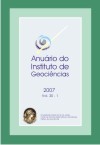Domal type stromatolite from Lagoa Salgada, Rio de Janeiro State, Brazil
DOI:
https://doi.org/10.11137/2007_1_50-57Abstract
The lagoa Salgada is situated on the north coast of the State of Rio de Janeiro, between the districts of Campos dos Goytacazes and São João da Barra, at 41º00'30'' W and 21º54'10''S. In the margins of the lagoon the presence of recent stromatolitic constructions was verified. The stromatolite may be defined as lithified biosedimentary structure, growing through the increase of sediment blade trapping by the carbonate precipitation as result of microbian organism activity. The objective of this study was to describe and to determine the internal morphology of domal type stromatolite of the lagoa Salgada. Through cutting, three different stages were observed: the first (base) is present as a thrombolitic stage with spread blade; the second (intermediary) is a thrombolitic-stromatolitic stage with spread and continuous blade; the third (top) is stromatolitic and the most recent stage of the structure, presenting continuous blade and with interruptions rare. Besides the presence of cyanobacteria and mollusk shells, were observed also internee palinomorphs inside the domal stromatolite. It was possible to observe that filament cyanobacteria contributed to the formation of blade of domal stromatolite and the microgastropod contributed for the destruction of the blade.Downloads
Download data is not yet available.
Downloads
Published
2007-01-01
How to Cite
Silva e Silva, L. H., Iespa, A. A. C. and Damazio-Iespa, C. M. (2007) “Domal type stromatolite from Lagoa Salgada, Rio de Janeiro State, Brazil”, Anuário do Instituto de Geociências. Rio de Janeiro, BR, 30(1), pp. 50–57. doi: 10.11137/2007_1_50-57.
Issue
Section
Article
License
This journal is licensed under a Creative Commons — Attribution 4.0 International — CC BY 4.0, which permits use, distribution and reproduction in any medium, provided the original work is properly cited.















